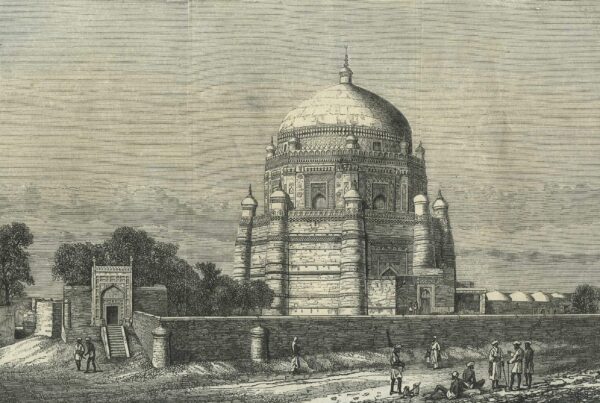The ancient Semitic language known as Aramaic was found in the Middle East thousands of years ago and was the language associated with many Abrahamic figures and Islamic prophets. The ancient language found it’s way into modern Pakistan some 2500 years ago blending with local influences to create a new native script for one of the most major languages of the Indus basin.
Of the rise of Aramaic and Kharosthi in the Indus basin.
Aramaic is a Semitic language which developed thousands of years ago in the levant and with the rise of civilization played a dominant role in imperial administration due to its adoption by a number of empires and kingdoms.
It was also the language of multiple Abrahamic figures of which the most significant from the Islamic scope is the Prophet Isa (A.S.) or as he is known by his biblical name: Jesus. The prophet Isa (A.S.) being a resident of Nazareth was exposed to Aramaic which was the lingua Franca of where he dwelled. The dialect of Aramaic that was found in his region was known as Galilean.
Now this begs the question, how exactly did a Semitic language from the levant find itself so distant from its source in the areas which now form Pakistan? For this we go back to the political outlook of the Indus basin in the Late Vedic era.
The movement of Aryans into South Asia is usually divided into 3 portions i.e. the Early-Vedic, Vedic, and Late-Vedic eras. Though to cover the first two would require a separate piece in its own, by the end of the third the ever expanding Aryans had spread over the greater portions of South Asia covering much of the Indo-Gangetic plains with their own polities and city states and were embroiled in their own 2 spheres in the basins of the Indus and Ganges rivers. For the greater part, the Aryans were either at war within themselves or attacking neighboring states to the point that either one state could subsume various others to gain much power or their internal feuds would result in greater fracturing of states and an overall weak outlook of the region.
In the same era that our areas were busy in these petty feuds, far west in Persia Cyrus the great had founded possibly one of the most significant early empires of Asian history which would go on to stretch over a vast portions of the old world, the empire known as ‘The Achaemenid empire’. Cyrus’ successor Darius took full advantage of the weak political outlook of the Indus basin and became arguably the first outsider to invade the Indus basin. Darius succeeded in taking over everything from Gandhara in the north to Sindhu in the south. Thus the Achaemenid’s held everything from modern KPK till Sindh along the Indus River.
It is due to the Achaemenid empire that certain areas which today form Pakistan are mentioned in the bible. The book of Esther, whilst speaking of the extant of the empire, mentions the Indus Valley as Hoddu: a cognate of the name Hindush which itself came from the name Sindhu/Sindh. Though due to the fact that the name India (Lit. land of the Indus) and its cognates are derived from the name of the Indus Valley (Sindhu > Hindush > Indos > Indika > India), most English translations refer to Hoddu as India and neither as the Indus Valley or Sindh to which the word was a reference to.
The Achaemenid contact with the Indus basin led to great cultural exchange. Not only did warriors from modern Pakistan take part in the Achaemenid wars in Greece such as at the famous battles of Marathon and Thermopylae but the university Of Taxila, possibly one of the earliest centers of learning in the world, also functioned in this age.
More significantly, the Achaemenid yielded centralized control in the form of satrapies and a complete administrative system built on a functioning Bureaucracy. In order to run such an administrative system there were Satraps (governors), commanders in chief, collectors of taxes, inspectors, police, spies and secretaries and government institutions. This system needed a language to function, and this language was Aramaic which was the imperial language of the Achaemenid empire. The language was adopted by Darius I as the lingua Franca and the official language of the empire for effective diplomatic communication and contact between the various diverse peoples of the vast empire. Thus for nearly 300 years or more, Aramaic was used in what is now Pakistan for administrative purposes.
Though even after the fall of the Achaemenid empire with Alexander’s invasion, the language persisted. This happened by the creation of the Kharosthi script. With the invasion of Alexander and the subsequent fall of Achaemenid control in modern Pakistan, the bureaucracy and Aramaic readers were on their way out with the ruling class being exchanged with Greeks who retained the usage of the Greek language. The locals came upon a dilemma realizing that the usage of Greek for administrative purposes would be just as difficult as requiring for the Aramaic readers to stay since both were foreign languages requiring extra knowledge for efficient usage. Thus arose a need for a new written script for business records, land records, trade records, authoritative documents, legal and judicial documents, and court decrees etc.
So the socioeconomically strong fraction of society pushed for the promotion of a new script which ended up being formed through the modification of the Aramaic script to suit the local language of the ancient region of Gandhara in northern Pakistan known as Gandhari.
Though mainly used in the Gandhara, it spread vastly. Kharosthi inscriptions have been found in northern Afghanistan, southern Uzbekistan, and parts of Tajikistan. It has also been found in the Ganges plain in Mathura and in the Tarim Basin of modern day Xinjiang in China. The Kharosthi script existed in the same era as the Brahmi script of the Ganges Basin and Peninsular India. Kharosthi was in many ways different to Brahmi which was much more successful and widely used. In general, Similar to the usage of most languages of the Indus basin since the Indus script to modern languages, Kharosthi was written right to left rather than the Brahmic left to right. It’s writing was also much more cursive owing to its relations with the Semitic script.
The language was short lived and reached its zenith under the Kushan empire. It’s reported 600 or more years of existence was for the most part wiped out after the decline of Gandhara. However Dardic languages of Northern Pakistan still retain similarities with the ancient Gandhari language due to multiple factors. These include Khowar (Chitrali), Kalasha, Torwali, Gawar Bati, Shina etc. The reason behind these similarities are an ongoing debate. It is not proven whether they descended from Gandhari, or were influenced by it, or by some other factor. What we know is their isolation in the mountains, especially of Khowar, retained a lot of archaic properties.
References:
Literacy in Ancient Everyday Life – A. Kolb
Indo – Aryan languages – D. Jain, G. Cardona
Grandeur of Gandhara – R. Samad
The Buddhist Literature of Ancient Gandhara – S. Richard
A short history of Pakistan – I.H. Qureshi
Foreign influence in Ancient India – R. A. Jairazbhoy
Buddhism in the Iranian World – Richard Foltz

Ancient History
The Ancient Spread of Aramaic in Pakistan
About Me
Peshawar, Khyber Pakhtunkhwa
Pakistan
25000
Email: mhuzaifanizam0118@gmail.com



